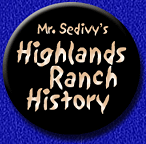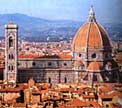|
|


Mr. Sedivy's
History Classes:









More Features:


 




|
|
Highlands Ranch High School - Mr. Sedivy
Highlands Ranch, Colorado

- Colorado History -
The History of Littleton, Colorado
Littleton in the 1870s:
Railroads, Littleton's First Church,
The Highline Canal
August 1871
The Denver and Rio Grande railroad began laying rails east of Richard
Little's homestead.
October 28, 1871
The first Denver and Rio Grande railroad train steamed down the rails
near the farm of Richard Little.

January 1872
The Rough and Ready Flour Mill was destroyed by fire. It was a $40,000
loss, but reconstruction of the mill began immediately. By autumn,
the new mill had orders for fifty carloads of flour.
June 3, 1872
Richard Little filed a plat of his land, and mapped out a town-site
for the village of Littleton. The boundaries of Little's land were
the South Platte River on the west and the Denver and Rio Grande railroad
tracks on the east - eighteen blocks of land, with some blocks subdivided
into nine - twenty lots. Richard Little was now also in the business
of selling real estate.
The Rocky Mountain News wrote:
| |
A Day at Littleton
This thriving little town,
ten miles south of Denver, is the center of a magnificent farming
section, there being in the area - bounded by the Platte (on
two sides), Bear Creek and the foothills - about thirty-five
thousand acres of land, the principal part of which either is
or can be irrigated. From Bradford Hill can be seen seventeen
lakes, varying in size from an area of ten to two hundred acres.
These lakes have been formed within a year or two by turning
water from the irrigation ditches into natural depressions,
making reservoirs which are very valuable to those who own them.
In the immediate vicinity
of the village of Littleton are the farms of R. S. Little, G.W.
Belcher, A. C. Hunt, J. W. Bowles, Henry Alhouse, J. Foster,
John G. Lilley, Peter Magnes, R. T. Hussey, W. B. O. Skelton,
B. N. Sanford, S. W. Brown, and I. W. Chatfield. Their farms
are under the upper Platte and Bear Creek ditch, which is about
six miles long and planted throughout with cottonwood. Mr. A.
J. Johnson gives the following from his books as the result
of last year's operation on the farm of Hon. John G. Lilley.
Returning to the village
we find that thirteen buildings have been erected during the
last year, the most important of which is the Rough and Ready
flour mill. This building is 45 x 64 feet, and five stories
high. There is a brick office 12 x 20 feet, having a fire proof
vault. The machinery consists of four pairs of burrs, each driven
by a centre-vent turbine water-wheel, made by Hugh Marshman
of Mt. Vernon, Colorado, of a capacity (each) of thirty two
horse-power; Bernard separator; Eureka smutter; Pease scourer;
and Little Giant feeder, all manufactured by E. P. Allis & Co.,
Milwaukee, Wisconsin.
The old mill was burned
January 24, 1872, and the present building was finished and
the machinery running May 2, of the same year. There was one
hundred and fifty thousand feet of timber used in the construction,
which was got out and delivered on time by the Sloan Saw-mill
company. Considering the difficulty of building at that season
of the year, the distance the timber and machinery were brought,
it was a feat not often equalled.
Messrs. Little, Lilley
& Co. have received several special orders for large quantities
of their celebrated flour from the states, and are now grinding
for a shipment of one thousand barrels to be sent to Boston
and sold on its merits. The barrels are brought from Kansas
City in "knock down" shape, and set up here. It will be a notable
event for Colorado when flour in barrels is shipped to the Atlantic
states and sold in competition with the celebrated brands that
have so long ruled the market. The firm have ground of last
season's wheat 40,000 bushels; have 20,000 in store; and estimate
that there are still about 40,000 bushels held by farmers in
the neighborhood.
Some enterprising citizens
of Littleton starting a hack to make daily trips to Denver and
return, it being possible to finish transportation at cheaper
rates than is at present afforded by the Denver and Rio Grande
railroad. Two new roads to Denver will be open next season,
one on the west side of the Platte - the extension of the Boulevard
road - the other the extension of Broadway. These roads run
parallel lines and are two miles apart, crossing the Platte
at Littleton.
|
|
1872
Littleton's first church was built on Rapp Street. Little had donated
a lot near the corner of Rapp and Church streets and helped finance
the building of a church. Bishop James Maxwell Randall consecrated
that structure as St. Paul's Episcopal Church in April 1872. By 1874,
it gained its first permanent priest, Charles De Garmo. Within a short
time, a rift developed within the congregation, and a second Church
was established and called the Reformed Episcopal Church. The First
Presbyterian Church was organized in 1883, giving the community religious
diversity.

St. Paul's Episcopal Church, Littleton's First Church
1873
By 1873, it was decided that a brick school was to be built in Richard
Little's new village, near the corner of Rapp Street and Church Street.
During the late 1870s, some 70 students were attending the brick school
- so many students that the single teacher had to have the help of
older students who acted as monitors.
1873
The Denver and Rio Grand depot was built in Littleton.

The Rio Grande Railroad Depot in Littleton
1874
The Denver, South Park and Pacific Railroad was built west of the
South Platte River. Passing west beyond the village of Littleton,
its rails headed up the Platte Canyon westward - that route is today's
Lowell Blvd. and Platte Canyon Road. The track was completed in 1880,
and ended in Leadville. (The railroad was also known as the Colorado
and Southern Railroad, and was finally abandoned in 1937.) Its depot,
located west of the South Platte River, created a rival village called
West Littleton, or Wynetka upon its incorporation in 1890.
1874
A second fire destroyed the Rough and Ready Flour Mill, but it was
rebuilt again - this time in stone and brick. (This building lasted
until 1959.)

Richard Little's Rough and Ready Mill, Pictured in
1908
1879
Highline Canal water rights were established and canal construction
began, to be completed in 1883. In 1879, a major water project was
developed nearby, winding its way northward from the mouth of Platte
Canyon. Known as the Highline Canal, the seventy-four mile length
of canals dropped uniformly at thirty-two inches per mile. British
investors supplied the capital for the project through the Northern
Colorado Irrigation Company, known locally as the "English company"
- the construction costs totaled $650,000. The English company proposed
to place a million acres under cultivation, but they had difficulty
securing sufficient water because earlier ditches held irrigation
rights based on prior claims. Court cases regarding water rights resulted
and dragged on for years.

The Highline Canal in Platte Canyon, pictured in 1894
The History of Littleton, Colorado
1. | History
of Littleton: Prehistory - 1859 Colorado Gold Rush |
2. | Littleton in
the Early 1860s / Founding Fathers |
3. | 1860s:
Lewis Ames, Littleton's First Teachers and School,
Indian Troubles and Early Buildings in Littleton |
4. | Littleton
1870 - 1879: Railroads, 1st Church, Highline Canal |
5. | Littleton
in the 1880s: Avery Gallup, First Newspaper |
6. | The
City of Littleton in the 1890s: First Mayor, Pickletown |
7. | 1900s:
South Arapahoe County, Littleton Named County Seat |
8. | Littleton 1910
- 1920s: Town Improvements / Industry |
9. | Littleton, Colorado
in the 1930s and 1940s |
10. | The Boom of
the 1950s and 1960s in Littleton, Colorado |
11. | Littleton:
1970s to Present, Concrete Pods and All |
12. | Littleton Trivia
and Stuff You've Always Wondered About! |
Back to the top of page
- Colorado History In Depth
-
Lecture Notes, Reading, and Information:
| The Cheyenne Migration
to Colorado |
| The Gratlan Affair, Massacre, Fort Laramie
Treaty |
The Cheyenne Social Club
| A Cheyenne War Story: Wolf Road, the Runner
|
| Cheyenne Traditions and Beliefs, Sacred
Stories |
| Horses, Warriors, War Pipe, Sweatlodge
Ceremony |
| Cheyenne War Parties and Battle Tactics
|
| The Scalp Dance and Other Cheyenne Dances
|
Fort Union
| The Sante Fe Trail and Fort Union |
| Sumner - Ninth Military Department / The
First Fort Union |
| Early Arrivals to Fort Union, Daily Life
at Fort Union |
| Captain Grover - The New Fort Union, the
Confederate Threat |
| Fort Union Arsenal, William Shoemaker,
End of Fort Union |
Americans from the East
| Thomas Jefferson, the Louisiana Purchase
|
| The Expedition of Zebulon Pike |
| Pikes Peak or Bust / Colorado Gold Rush
|
Colorado's Role in the US Civil
War
| The Civil War, Fort Wise / Fort Lyon
|
| Mace's Hole, Colonel Canby, F.C.V.R.
| Fort Weld |
| The Pet Lambs, John Chivington |
| General Henry Sibly, Battle of Valverde,
Fort Union |
Cripple Creek District Labor Strikes
| The Western Federation of Miners / State
Militia |
| The 1893 - 1894 Strike | The
Strike of 1903 - 1904 |
| The Mine Owners Association |
| Crimes and Military Rule in the Cripple
Creek District |
| Marshall Law in Cripple Creek District
/ End of the Strike |
Early Cripple Creek District
| Photos, Fire, and Life in Cripple Creek
|
| Other Colorful Towns in the Cripple Creek
District:
Gillett - Colorado's Only Bullfight, Victor, Independence |
| A Guide to the Miners' Gritty Lingo
|
More Colorado History
Information
| Bent's Fort Photos, Personalities, Plans,
and More |
| What Was Easter Like at Bent's Fort?
|
| Colorado Trivia,
Miscellaneous Old Photos,
Western Personalities, Forts, and More |
| Lullabies for Jittery Cows - Cowboy Ballads
|
| Heraldry of the Branding Iron |
| Project
Aims to Clear Infamous Cannibal, Alferd Packer |
| Lead Gives Alferd
Packer's Story More Weight |
| Legendary
Colorado Love Stories: Baby Doe Tabor & More
|
| Colorado Pioneer Women: Elizabeth Byers
|
| Early Denver Jokes / The History of April
Fools' Day |
| History of the US Memorial Day Holiday
|
Back to the top of page
|
|
|



![]() 9375 South Cresthill Lane
9375 South Cresthill Lane ![]() Highlands Ranch, Colorado 80126
Highlands Ranch, Colorado 80126 ![]() 303-471-7000
303-471-7000





